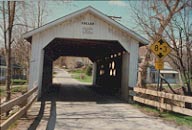
The Fuller Covered Bridge Inspection Report In Brief
Description:
Built in 1890 by Sheldon and Savanna Jewett, the bridge is constructed with a plank lattice truss similar to the truss patented by New Haven Connecticut architect Ithiel Town. The lattice members are 3" x 11" plank. Bridge length is 49.7 feet. Bridge width C - C: 18.29 feet. Bridge width, inside clearance:16.83 feet. Vertical clearance: 11.33 feet. The deck is 2" x 4" nail laminate. The siding is vertical 'inch' plank unpainted. Roofing is metal, The gable ends, portals and splash panels are painted white. The roof construction is typical of all of the Jewett bridges: 6" x 6" tie beams with lateral bracing; 6" x 6" ridge pole supported at each tie beam on 6 x 6 cats. The south abutment is mortared stone, the north, cast concrete.
Inspection report: April, 1993
Traffic Study results: 1993: 360 vehicles per day
Structural Evaluation: Rotted areas of top chords, lower chords have large cracks, insect damage, wooden pins partially pushed out, end floor beam at abutment #1 missing, bearing blocks tipped. Sections of bottom chords are rotten and crushing at bearing blocks. Horizontal bearing beams cracked or crushing.
Option D requires repair of trusses, replacement of bearing timbers, floor beams and decking, guard rail and signs.
Recommendation: For short term solution Option D - Rehabilitate for moderate traffic to capacity of 40,000 pounds. The current floor system will have to be replaced. The estimated cost (1993): $135,000
For long term solution Option E - Relocate the structure to a preservation site, build new structure at estimated cost of $215,000.
[The flood of June 15, 1997 damaged the bridge and necessitated the installation of a steel girder to support the upstream truss.]
The Covered Bridge Inspection Program:
In the spring of 1995, the Vermont Agency of Transportation completed the inspection of the seventy-five covered bridges that serve state and town highways. In the course of the survey, some of the bridges were found to be unsafe and were closed to traffic -- others were found to be in need of repair.
The inspection program was part of a long-range plan to oversee public safety, plan for current and future traffic needs, and to preserve all of the covered bridges in the state. The structure of each bridge was inspected for safety, and the bridge traffic was evaluated. The results of the study were turned over to the local communities with recommendations to help them decide whether to repair, rehabilitate, or replace their covered bridges. The towns, ultimately responsible for a share of the funding, will decide what work will be done.
The recommendations include one of five options based on the condition of the bridge and the type of traffic the bridge supports:
- Option A: The community may close the bridge to vehicular traffic, with traffic diverted to existing roads and bridges.
- Option B: The community may continue to use the bridge for light vehicular traffic, with heavier truck traffic diverted to other routes.
- Option C: The community may close the bridge to traffic and construct an adjacent bypass bridge.
- Option D: The community may rehabilitate the bridge to support moderate traffic safely.
- Option E: The community may replace the bridge and move it to a nearby preservation site.

